SteveHiggs.com
Web Developer, PC & Mac Specialist, Web Consultant, and Graphic Artist in Peterborough, OntarioRamblings
Links found in this article:

LIFX WiFi Enabled LED Light Bulbs
Over a year of excitement and anxious waiting finally culminated with a quick flip of a switch and an impressive array of colours dancing about.
I've been watching every unboxing video on YouTube as they're posted. Everyone's receiving their Kickstarter edition of LIFX's new WiFi Enabled LED Light Bulbs. It sure seemed like mine was the last to ship!
To my understanding, this was the most successful campaign in Kickstarter's history! The campaign closed November 14th 2012, raising $1,314,542 (their original goal was only $100,000). It was at that time that I started to tell my family and friends all about the exciting new light bulbs I'd be receiving very soon! The shipping estimate was March of 2013 so it wouldn't be long at all!
Well, it's been a year and two months since the campaign had closed and the long wait is finally over! Those family members and friends who suffered through my endless ramblings can finally have some rest. I have my LIFX bulb. And my first thought upon powering it on? These colours are so much more vibrant than I expected! This is so cool!!
Setup:
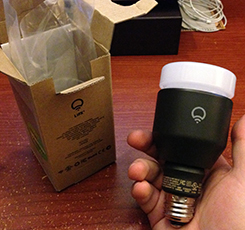
Setup of the LIFX bulb was dead simple. Take it out of the box, screw it into a lamp, and flip the switch to turn on the bulb. By default, the bulb emits a bright white light until you link to it with your iOS or Android device.
Connecting to the bulb for the first time involves switching your devices' WiFi network to the bulb's own "LIFX Bulb" network (the password is provided in the instructions on the app). This network is only present for the setup process.
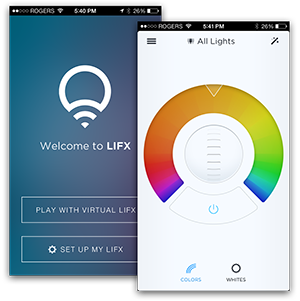
Returning to the LIFX app, you're asked to choose a WiFi network for the bulb to use going forward, and to enter the password for that network. After that, the device should complete the remaining steps automatically. Following a successful connection, your iOS or Android device should automatically switch back to your normal WiFi network where the bulb is also now just another client on the network.
Playing with Colour:
During my long wait for this first bulb to arrive, I had plenty of time to imagine the many use cases and ways that I would take advantage of all the new features my lights would (soon?) have. I admittedly wasn't sure how much the colour feature would be used! I'll explain a little later about the many ideas that will become possible with the release of LIFX's APIs (Application Programming Interfaces) allowing developers to write apps on all platforms to interact with the bulbs directly! That's where my imagination was running wild; not as much on the question of "What colours will I use?"
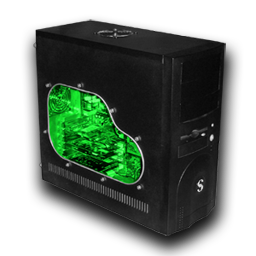
A quick glance back in time at my use of colour growing up shows a rather narrow perspective. I grew up liking one or two colours specifically. I recall a rather obsessive, very geeky young Steve who's computer was painted black, with an acrylic window put into the side, allowing bright neon green light to spill out into the otherwise dark room. I had green LED fans, green cold-cathode lights, and even a custom made flashing green "S" symbol on the front that blinked to the HDD activity! (I know.. Cool right!? I have it here sitting just behind my Mac that has long since replaced it. But it's still fun to power on now and then to bask in the green glow! :P)
Suffice it to say, green, and a little later blue, were often employed in my artwork, web designs, and the other expressions of my imagination.
But would I use these colours, or any of the thousands produceable by the new bulbs? Sure, I'd have a choice of warmer whites like an incandescent bulb, or a more sterile, industrial blueish white light, and brightness would certainly be a feature used often. But colour?
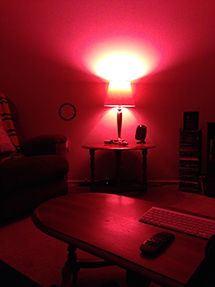
Well one minute after setup, I knew I'd be hooked on the new found ability to COMPLETELY change the feel of a room just by a simple swipe across my phone's screen. I mean the red that LIFX can produce is stunning! And the indigos and oranges; all these colours that I never had any use for when I was that geeky teenager modding my computer. They're all actually quite incredible. Ok, so maybe I'm no less geeky today, and perhaps obsessing over the beauty of a coloured light is still a tad overboard, but screw it, this is awesome!
Positioning:
One bulb. That's all I ordered (at first). So of course the rest of the evening after it had arrived was spent taking it from room to room. I was trying it in different lamps and sockets that only weeks before I had been holding a measuring tape up to just trying to imagine how far the new bulb might stick out (as it is longer than your average bulb). Link: LIFX bulb measurements
The LIFX bulb fit in most of the lamps I tried it in. The smaller lamp in my spare bedroom doesn't leave enough clearance for the bulb to fit unfortunately, and with my two living room lamps I have to remove the metal arch to put the bulb in, then place the arch back on (which holds the lamp shade) but it does fit.
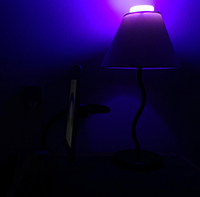
Fitting isn't the only hurdle with a bulb that is rather oddly shaped either. Consider where the light comes from on most bulbs. LIFX bulbs produce their light from the top rather than the centre. This seems to be common for LED bulbs, but especially so with LIFX. This can be a comical sight when, for example, I placed my LIFX bulb in a smaller bed-side lamp! The entire light producing part of the bulb was above the lamp shade! So, new lamps may be required depending on your use case.
While I had anticipated the light coming from a slightly different part of the bulb being a potential concern, another completely unexpected "issue" if you want to call it that, was the bulb's weight!
I have a three bulb chandelier above my dining room table. Placing one LIFX bulb in this chandelier causes the entire thing to tip to that direction! But perhaps the easy solution here? Buy three LIFX bulbs!
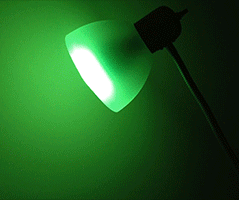
Also, a gooseneck lamp that is an offshoot of a tall floor lamp suffers from the same unanticipated extra weight of the LIFX; instantly it drooped down when I placed the bulb in that socket. But some creative bending of the arm and all is fine!
There's bound to be a few odd situations since the LIFX bulb is an odd shape, size, and weight. But all in all, most of the sockets I tested the bulb in were perfectly fine adapting to my new bulb of choice.
Future features:
So at the time of writing, as one of the Kickstarter backers for LIFX, there's many features I had been anticipating, that are presently missing. A few that were advertised in the Kickstarter video presented over a year ago, and a few that were dreamed up and will require a bit of effort when the time is right.
LIFX has been slowly evolving the LIFX app, only providing very basic features upon first release. You can turn on/off your bulbs, choose from any white or any colour, brightness, and even save these settings into a "scene" (per device) for recalling quickly later on.
However LIFX has expressed their intentions to build in a few features in very near future. Features like a wakeup "alarm" where one can schedule the bulbs to slowly fade in like a sunrise to wake you in the mornings. Also the ability to have your lights simply pulse once or twice to blue for example when a Facebook update or message comes in. But the feature I'm looking forward to the most? Integration with services like IFTTT (If This Then That) and the open API's LIFX will soon be making available to developers!
I won't go into too much detail here because I'm sure I could write 20 pages if I get too excited! But imagine a few situations here: You come home from work and as your smart phone's location reaches your place, your lights can fade on for you. Or, perhaps you forgot to turn off the lights before leaving for work? Your lights will turn off automatically (based on either a schedule, or you phone's GPS location).
Without grabbing a phone or tablet, you could simply say "Dim lights" anywhere in the room, and the computer sitting off to the side can interact with the LIFX bulbs and dim them for you. "Movie mode" could dim your lights to just the right brightness for a movie, and "Pee break!" could raise the lighting to the bathroom for you! Perhaps the geekiest of all my LIFX ideas? Stating "Red Alert!" pulses all the lights red, and sends a lock signal to my door's smart lock, and plays a Red Alert sound in each room! Yes, I'm a Trekkie, could you tell? Oh what joy this could bring! Perhaps a few headaches too. :P
Simple integration with online services like IFTTT could allow you to fade the lights in the morning to a blue colour on colder days, or to a warmer tone when the weather is going to be warm. There's no need to ask Siri what the temp will be like!
Even a slow, gradual decrease in brightness reminding you it's time to head to bed! I mean countless ideas come to mind, and these things all become possible with the release of the LIFX API. Which is apparently LIFX's top priority at the moment, to be released very soon.
In comparison to Philips Hue:
Well it's no secret that the Philips Hue product line has held it's ground in the smart lighting market while LIFX was hard at work. I don't know if they took the idea from anyone else; I mean if you consider that the "internet of things" movement is happening all across the tech industry. Lighting is bound to be a hot topic and an area of intense growth over the next while.
From my perspective: In the time it took LIFX to introduce the idea on Kickstarter, raise funding, arrange distribution deals, setup factory production lines, revise the product design, and achieve FCC and UL certifications... Philips was able to produce, advertise and sell the Hue products. Philips is a very well known manufacturer and would have had the infrastructure already in place. Advertising and funding would have also been relatively simple in comparison to the struggles for a new startup company.
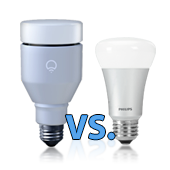 Comparing the two products we see:
Comparing the two products we see:
- Philips Hue line has a maximum brightness of 600 lumens, and LIFX has 1000 lumens.
- Philips Hue requires a hub to be connected to your home router to act as the middle man between your bulbs and the network whereas LIFX bulbs each contain the networking components required to be self contained units. This means a lower barrier to entry.
- However LIFX is a tad more expensive at $89.95 a bulb vs. Hue's $59.95 a bulb.
- LIFX bulbs are certainly bigger and heavier than Philips Hue bulbs so therefor they may not fit where Philips can.
- There's reports of Philips Hue bulbs buzzing/humming whereas my LIFX has been absolutely silent during operation, albeit a tad hot at times.
I don't know if those are significant drawbacks or advantages for those reading this review, but for me, I bet my dollar on LIFX early on before Hue was ever announced, so I stuck with them and am quite pleased with the end result. But I can't express the envy I had while others were buying Hue bulbs and I was waiting, and waiting, and waiting for LIFX to release!
Final Thoughts:
The one LIFX bulb I currently have sure needs some friends! I have more coming in the next few batches and I will have to limit myself only due to the potential financial side effects if I don't!
There's a few odd glitches with the first bulb I received (sometimes not remembering the settings the bulb was last at when turning it on/off with the wall switch for example). But since I've been watching the LIFX Twitter account I know these items will be worked out in coming firmware updates and am not concerned there.
It would seem the extended manufacturing time had given LIFX time to hone their product and really produce an awesome new breed of smart lighting. I'd highly recommend the product to those who want the features I've talked about and who just want to geek out with WiFi in their light bulbs!